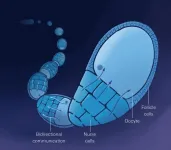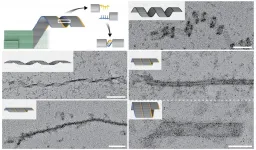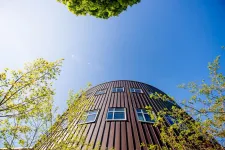UMass Amherst researchers develop ultra-sensitive flow microsensors
Research could lead to more breakthroughs in neuroscience, metabolism
2021-03-22
(Press-News.org) A team of scientists at the University of Massachusetts Amherst have developed the thinnest and most sensitive flow sensor, which could have significant implications for medical research and applications, according to new research published recently in Nature Communications.
The research was led by Jinglei Ping, assistant professor of mechanical and industrial engineering, along with a trio of mechanical engineering Ph.D. students: Xiaoyu Zhang, who fabricated the sensor and made the measurement, Eric Chia and Xiao Fan. The findings pave the way for future research on all-electronic, in-vivo flow monitoring in investigating ultra-low-flow life phenomena that is yet to be studied in metabolism processes, retinal hemorheology and neuroscience.
Flow sensors, also known as flowmeters, are devices used to measure the speed of liquid or gas flows. The speed of biofluidic flow is a key physiological parameter but existing flow sensors are either bulky or lack precision and stability. The new flow sensor developed by the UMass Amherst team is based on graphene, a single layer of carbon atoms arranged in honeycomb lattice, to pull in charge from continuous aqueous flow. This phenomenon provides an effective flow-sensing strategy that is self-powered and delivers key performance metrics higher than other electrical approaches by hundreds of times. The graphene flow sensor can detect flow rate as low as a micrometer per second, that is, less than four millimeter per hour, and holds the potential to distinguish minimal changes in blood flow in capillary vessels. The performance of the graphene flow sensor has been stable for periods exceeding half a year.
Ping says the device his team created is the first one to be self-powered and high-performance, and it holds the potential to be implanted for long-term biofluidic flow monitoring. The most straightforward application, he added, may be in healthcare. To implant a micro flow monitor like the one his team developed in a small blood vessel is much simpler and safer than existing flowmeters, which are not suitable for low-flow measurement and need to be installed in a larger blood vessel. Ping added that scientists and doctors may find it useful for their research and clinical applications, such as monitoring the blood flow velocity in deep-brain vessels to understand the functioning of neurons that control the flow of blood.
Graphene is the key material in development of the sensor, Ping said. The unique combination of intrinsic properties of graphene, such as ultra-high sensitivity, ultra-low electrical noise, minimal contact electrification with aqueous solutions, outstanding stability in chemical and mechanical behaviors and immunity to biofouling, work together to induce the high performance of the flow sensor.
Next steps for Ping and his team include integrating the flow sensor into a self-sustained flow monitoring device and exploring the application of the device in healthcare.
INFORMATION:
[Attachments] See images for this press release:

ELSE PRESS RELEASES FROM THIS DATE:
2021-03-22
A cast of so-called 'nurse cells' surrounds and supports the growing fruit fly egg during development, supplying the egg -- or 'oocyte' -- with all the nutrients and molecules it needs to thrive. Long viewed as passive in this process, the Drosophila egg actually plays an active role not only in its own growth, but also in the growth of the surrounding nurse cells, Princeton University researchers report on March 21 in Developmental Cell.
"Here we show an example of bidirectional communication -- a dialogue -- between different cells. The egg is taking an active hand in controlling its own feeding ...
2021-03-22
Scientists from the Department of Physiology of the University of Granada (UGR) have shown that caffeine (about 3 mg/kg, the equivalent of a strong coffee) ingested half an hour before aerobic exercise significantly increases the rate of fat-burning. They also found that if the exercise is performed in the afternoon, the effects of the caffeine are more marked than in the morning.
In their study, published in the Journal of the International Society of Sports Nutrition, the researchers aimed to determine whether caffeine--one of the most commonly-consumed ergogenic substances in ...
2021-03-22
LAWRENCE -- When a franchise buys a superstar like Tom Brady or LeBron James, the team tends to win more games. But do the fans follow? How much team loyalty is purchased along with an expensive star? Maybe not as much as some owners might hope -- in the NBA Finals between the Miami Heat and San Antonio Spurs, many fans expressed their dislike of the "bought" Miami team.
In a new paper published in the peer-reviewed Journal of Applied Social Psychology, researchers at the University of Kansas asked over 1,500 Americans how much they liked teams that purchased excellence and compared that with liking teams that built excellence from the ground up.
"People reliably ...
2021-03-22
An international team of scientists from Nanyang Technological University, Singapore (NTU Singapore), Brown University and the Massachusetts Institute of Technology (MIT) has developed an artificial intelligence (AI) platform that could one day be used in a system to assess vascular diseases, which are characterised by the abnormal condition of blood vessels.
The AI-powered platform combines machine learning and a specially-designed microfluidic chip with analysis of 2D video images of blood flow and the application of physical laws, to infer how blood flows in 3D. In tests, it accurately predicted blood flow characteristics such as speed, pressure, and shear stress, ...
2021-03-22
The world needs more electricity. As populations grow, standards of living increase and more people gain access to modern conveniences, countries will need to expand their energy generation capacity.
India, with its rapidly developing economy and a population of more than 1.3 billion, epitomizes this trend. The country finds itself at a crossroads regarding its energy future: Small decisions today will resound in the coming years.
In their latest report, the Indian government set a target of 450 gigawatts of renewable energy capacity by 2030. For comparison, the country's total energy generation capacity today is about 380 gigawatts, out of which 90 gigawatts are of renewable energy, not including large hydropower stations. How this plan shapes up will dictate how ...
2021-03-22
(BOSTON) -- A team of nanobiotechnologists at Harvard's Wyss Institute for Biologically Inspired Engineering and the Dana-Farber Cancer Institute (DFCI) led by Wyss Founding Core Faculty member William Shih, Ph.D., has devised a programmable DNA self-assembly strategy that solves the key challenge of robust nucleation control and paves the way for applications such as ultrasensitive diagnostic biomarker detection and scalable fabrication of micrometer-sized structures with nanometer-sized features. Using the method, called "crisscross polymerization", the researchers can initiate weaving ...
2021-03-22
One of the surest signs of spring is the vibrantly lime-green tinge trees develop as their buds open and tiny new leaves unfurl. Bud-break is the scientific name for this process -- a straightforward term for the grand genetic mechanism that allows trees to leaf out and do their summer work of photosynthesis to store up energy for the coming winter.
Bud-break is precluded by bud-set, which occurs in the autumn. After trees have dropped their leaves and as the days shorten and grow colder, new buds grow on branches. Like many wildflowers, trees require a period of dormancy at colder temperatures -- a process fine-tuned by evolution ...
2021-03-22
DURHAM, N.C. -An unfortunate biological "feed-forward" loop drives cartilage cells in an arthritic joint to actually contribute to progression of the disease, say researchers at Duke University and Washington University in Saint Louis.
Pain researcher and mechanobiologist Wolfgang Liedtke, a professor of neurology at Duke, partnered with former Duke colleague and cartilage expert Farshid Guilak, now at the Washington University School of Medicine, to examine the activity of pressure-sensitive ion channels in cartilage. Their study appears the week of March 22 in the Proceedings of the National Academy of Sciences.
Cartilage is the highly lubricated, low-friction, elastic tissue that lines ...
2021-03-22
There are 12 essential attributes that explain why commercial carbon capture and sequestration projects succeed or fail in the U.S., University of California San Diego researchers say in a recent study published in Environmental Research Letters.
Carbon capture and sequestration (CCS) has become increasingly important in addressing climate change. The Intergovernmental Panel on Climate Change (IPCC) relies greatly on the technology to reach zero carbon at low cost. Additionally, it is among the few low-carbon technologies in President Joseph R. Biden's proposed $400 billion clean energy plan that earns bipartisan support.
In the last two decades, private industry and government have ...
2021-03-22
Amsterdam, NL, March 22, 2021 - The COVID-19 pandemic has had a profound impact on our world, with disequilibrium, uncertainty, and human suffering making it difficult to envision a human, societal and individual future. Milan Zeleny, PhD, Professor Emeritus of Management Systems, Fordham University, New York, NY, USA, and world-recognized authority on decision making, productivity, knowledge management, and more recently the corporation as a living organism, says that "COVID-19 is rapidly changing from a cause to one of the symptoms of an increasingly unhinged world."
Writing in the journal Human Systems Management, published ...
LAST 30 PRESS RELEASES:
[Press-News.org] UMass Amherst researchers develop ultra-sensitive flow microsensors
Research could lead to more breakthroughs in neuroscience, metabolism




